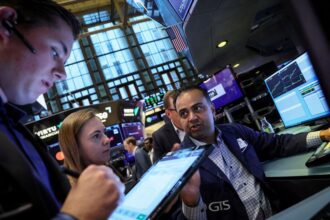The chorus of Federal Reserve officials who say interest rates will remain higher for longer than investors believe is getting louder.
The presidents of the Chicago and Cleveland regional Fed banks on Monday said Wall Street
DJIA
should not count on interest rates being reduced anytime soon.
Cleveland Fed boss Loretta Mester, in an interview with the Financial Times, said markets “got a little bit ahead” of the Fed on when to expect rate cuts.
The Chicago Fed’s Austan Goolsbee, for his part, said in a CNBC interview he was confused by the market reaction to the Fed decision to leave interest rates unchanged. The Fed last Wednesday left its benchmark short-term rate at a range of 5.25% to 5.5%.
After the decision, stocks soared to a record high, bond yields tumbled to a five-month low and investors moved up their expectation for the Fed’s first rate cut to March from the summer of 2024.
Why such a strong market reaction?
Fed Chairman Jerome Powell said after the Fed meeting that central bank officials had been discussing when to “begin dialing back” interest rates.
He sounded similarly “dovish in other comments, giving investors the impression rate cuts could come sooner than expected, economists say.
Yet Fed officials are worried by the market reaction.
Last Friday, New York Fed chief John Williams said the central bank “isn’t really thinking about” when to cut rates.
What’s more, Atlanta Fed President Raphael Bostic, seen as one of the most dovish senior Fed officials, said he was only expecting two rate cuts next year. Some Wall Street forecasters were predicting as many as seven.
Mester said Fed officials are mostly discussing how long they should keep rates high to make sure inflation is brought fully under control.
The Fed jacked up a key short-term U.S. interest rate to a top end of 5.5% from near zero in the spring of 2022 after inflation hit a 40-year peak of 9.1%.
Higher rates curb inflation by slowing the economy and reducing the demand for goods, services and labor.
The market reaction to Powell, however, resulted in a sharp decline in longer-term interest rates not directly controlled by the Fed. Lower rates tend to juice the economy and can worsen inflation.
The yield on the 10-year bond, for instance, fell to as low as 3.91% from 4.23% just a week earlier and as high as 5% as recently as a month ago.
The cacophony of comments by other senior Fed officials indicates they hope to readjust the expectations of investors.
The reason? Inflation might not slow to the Fed’s goal of 2% inflation as soon as officials would like. The current rate of inflation, using the Fed’s preferred PCE index, is 3%. And core PCE inflation is even higher at 3.5%.
While inflation has come down quite a bit, the large service side of the economy continues to suffer from elevated prices, including rents, transportation and recreation. Medical costs are also rising again.
That’s why Fed officials are trying to warn markets off.
“The next phase is not when to reduce rates, even though that’s where the markets are at,” Mester told the FT. “It’s about how long do we need monetary policy to remain restrictive in order to be assured that inflation is on that sustainable and timely path back to 2%.”
Read the full article here








